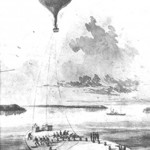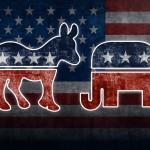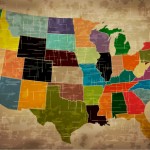Weekly Wrap Volume 33
 Why There is an Area of New York Called “The Bronx” and Why Ambulances are Called That
Why There is an Area of New York Called “The Bronx” and Why Ambulances are Called That
This is thanks to a seventeenth century Scandinavian man by the name of Jonas Bronck, originally from Tórshavn in the Faroe Islands. In 1639, Bronck immigrated to New Amsterdam in New Netherland, which was right next to what is today called Bronx River, named after Jonas Bronck. Why? In New Amsterdam, Bronck owned a 680 acre farm which was called, unimaginatively, “Bronck’s Land” and the river abutting it “Bronck’s River.” He held this land for just four years before… (more)
 The North’s Air Force During the American Civil War
The North’s Air Force During the American Civil War
If you thought that air warfare was reserved for a time after airplanes were invented, you thought wrong. During the American Civil War, the Union troops used hot air balloons to spy on Confederate troops. The idea to use balloons was the brainchild of Salmon P. Chase, the Secretary of the Treasury, and Joseph Henry, the Secretary of the Smithsonian Institution. They suggested that the military should create the balloon corps under the command of Thaddeus Lowe to do some “aerial reconnaissance” for the Union. On June 17, 1861, Lowe demonstrated his balloon in front of President Abraham Lincoln. He went up to the lofty height… (more)
 The Actress Who Played Elaine on Seinfeld is the Daughter of a Billionaire
The Actress Who Played Elaine on Seinfeld is the Daughter of a Billionaire
Seinfeld would have been a lot different with another actress playing Elaine, and that’s what would have happened if Julia Louis-Dreyfus had decided to live the life of an heiress rather than pursue acting. And that wasn’t out of the realm of possibility. Julia’s father is multi-billionaire Gerard Louis-Dreyfus and her family tree is littered with extremely wealthy and successful (in business) individuals going back over a century- as such Julia probably didn’t need to work a day in her life. You wouldn’t know it from listening to her, though. In an interview conducted on the Howard Stern Show in 2003, Julia… (more)
 How Much Caffeine Would It Take to Kill You?
How Much Caffeine Would It Take to Kill You?
There are several factors that make this a tricky question. Not everyone reacts the same way to caffeine. People also become tolerant to it and so the effects can be different from person to person. Lastly, there would be no respectable researcher who would dare perform a study on humans, if the goal of that study is death to that same person. All that being said, there are some very good studies that have allowed doctors to understand what’s going on inside the body in caffeine overdoses. They also have been able to presume the approximate dose that would prove fatal for the average person. So while the exact dose is… (more)
 How a Donkey and an Elephant Came to Represent Democrats and Republicans
How a Donkey and an Elephant Came to Represent Democrats and Republicans
The donkey is stereotypically bumbling, slow, and stubborn; the elephant– big and clumsy. Being compared to one of these animals is not exactly flattering in this sense. Yet, for well over a century, they have been the popular symbols of America’s major political parties – the donkey for Democrats and the elephant for Republicans. So how did the donkey and elephant enter into our political lexicon? As one could imagine, it all started with an insult. The 1828 presidential election between Republican (not to be confused with the modern Republican Party which was formed a few decades later) John Quincy Adams and Democrat Andrew Jackson is still considered one of the dirtiest campaigns ever run in American politics. Jackson and his supporters called Adams corrupt, spoiled, and a “libertine” – someone who lacked… (more)
Bonus Quick Facts:
- In the 18th century, salted beef or horse meat (usually low quality) eaten on sailing vessels as part of daily rations was called “salt junk” or just “junk”, making it technically the first food item called “junk food”. Around a century later “junk” had spread to refer to anything of low quality, though it wouldn’t be until around the 1970s that people would commonly start calling certain food items low in nutritional value “junk food”.
- Before launching the Chef Boyardee line of products, Chef Hector Boiardi, in 1915 at the age of 17 years old, supervised the catering for President Woodrow Wilson’s wedding reception.
- “Hangover” was a common term in the 19th century meaning “unfinished business”. Around the early 20th century, the common meaning shifted slightly to mean as it does today.
- Harry Houdini’s real name was actually Erik Weisz. When his family immigrated to America, they changed the spelling to Ehrich Weiss, which eventually resulted in people calling him “Ehrie” and later “Harry”. He picked “Houdini” as his professional name in homage to the French magician Jean Eugène Robert-Houdin. He added the “i” because a friend of his, Jack Hayman, told him adding the “i” at the end would make it mean “like Houdin” in French, which of course isn’t correct, but nevertheless resulted in “Houdini”.
- A white dwarf is a former star that is nearing the end of its life-cycle, with no further nuclear fusion going on at its core. Once most stars have used up the hydrogen at their core, they go into a red-giant or red super-giant phase and expand to incredible sizes thanks to remaining hydrogen in a shell surrounding the core. At the end of this phase, when the star has used up all its fuel that it can use via nuclear fusion, if it has enough mass, it will extremely rapidly collapse and create one of the most powerful explosions in the universe, the supernova. The burst of energy from a single supernova can briefly out-shine an entirely galaxy full of billions of stars. If the red giant doesn’t have enough mass, it will simply collapse into a white dwarf and spend a couple billion years slowly dimming as it gives off its stored energy. Some star remnants are too small to begin with and so don’t ever go into a red giant phase. When they do go into their “red” phase, they are called “red dwarfs”. However, the lifespan of these stars is longer than the universe has existed. Thus, every star that will eventually become a red dwarf is still around today and has not reached the red dwarf phase. As a general rule with stars, the bigger and brighter it is, the faster it burns out. The smaller it is, the longer it lives.
- It turns out, the panic response when a tarantula is crawling on your leg or the like is exactly what is happening when you are getting tickled. The body’s response to being tickled is panic and anxiety. It is thought that this is a defense mechanism for exactly the type of thing listed above where an external touch, such as a venomous insect crawling on you or the like, might be occurring. The body needs to react quickly to this unanticipated touch and without time for much conscious thought, so produces the panic reaction.
Other Interesting Stuff:
 The Engineer Who Bought Over 12,100 Cups Of Pudding to Earn 1.25 Million Air Miles
The Engineer Who Bought Over 12,100 Cups Of Pudding to Earn 1.25 Million Air Miles
Air Miles are awesome, they can be used to score free flights, hotel stays and if you’re really lucky, the scorn and hatred of everyone you come in contact with who has to pay full price when they travel. The king of all virtually free travelers is one David Phillips, a civil engineer who teaches at the University of California, Davis. David came to the attention of the wider media when he managed to convert about 12,150 cups of Healthy Choice chocolate pudding into over a million Air Miles. Ever since, David and his entire family have been travelling the world for next to nothing. So how did he do it? Well, first we need to explain the kind of man David Phillips is; he’s the kind of guy who reads every inch… (more)
 Why Are Vitamins Labeled A, B (and all the sub B’s), C, Etc.?
Why Are Vitamins Labeled A, B (and all the sub B’s), C, Etc.?
Easily identifiable by simple terms, the vitamins we recognize today were only recently isolated, identified and named. Roots of Vitamins: Scientists studying why animals failed to thrive (deficiency diseases) were the first to discover vitamins. One of these early researchers, Cornelius Adrianus Pekelharing, opined in 1905 that milk had “some unrecognized substance . . . in very small quantities [that] was necessary for normal growth and maintenance.” In 1912, while studying rice, Casimir Funk isolated an organic “factor,” which he described as amine (like an amino acid). Because it was vital to life, he combined the two words to coin the term… (more)
 The Origins of the Names of the 50 U.S. States
The Origins of the Names of the 50 U.S. States
Alabama: This southern state was named for the Native American tribe that lived there when the European settlers showed up. In their own language, they were called the Albaamaha. It’s likely that this name means something along the lines of “plant gatherers,” though this isn’t known for sure. While there isn’t much evidence about what the name means in their own language, their neighbours, the Choctaws, had two words that are similar: alba means plant, and amo means to cut or gather. In addition, it is known that the Albaamaha practiced agriculture. It’s thought that the Choctaws might have used those words to describe the Albaamaha, who then started calling themselves the resulting word. When European settlers arrived, they anglicized it to make it easier to pronounce and named the resulting state after the native residents. Alaska: This state name was also inspired by its native people. The Aleuts called the Alaskan Peninsula alaxsxaq, which means “the object toward which the action of the sea is directed.” Once again, this name… (more)
 36 Fascinating Baseball Facts to Kick Off the Season
36 Fascinating Baseball Facts to Kick Off the Season
A new baseball season is upon us and, to kick it off, we thought we’d do a roundup of all the interesting baseball facts we’ve covered on TodayIFoundOut to date to give you some interesting things to talk about as you while away the hours watching the games. Without further ado: Abner Doubleday Did Not Invent Baseball; The Only Major League Baseball Player to Openly Admit He was Gay During His Career Also May Have “Invented” the High-Five; There Once was a Little Person Who Played in Major League Baseball; Jackie Robinson was Not the First African American to Play Major League Baseball; The Woman Who Batted During a Major League Baseball Game; There was Once a Baseball Player Traded for Bats… (more)
This Week’s Podcast Episodes:
| Share the Knowledge! |
|




